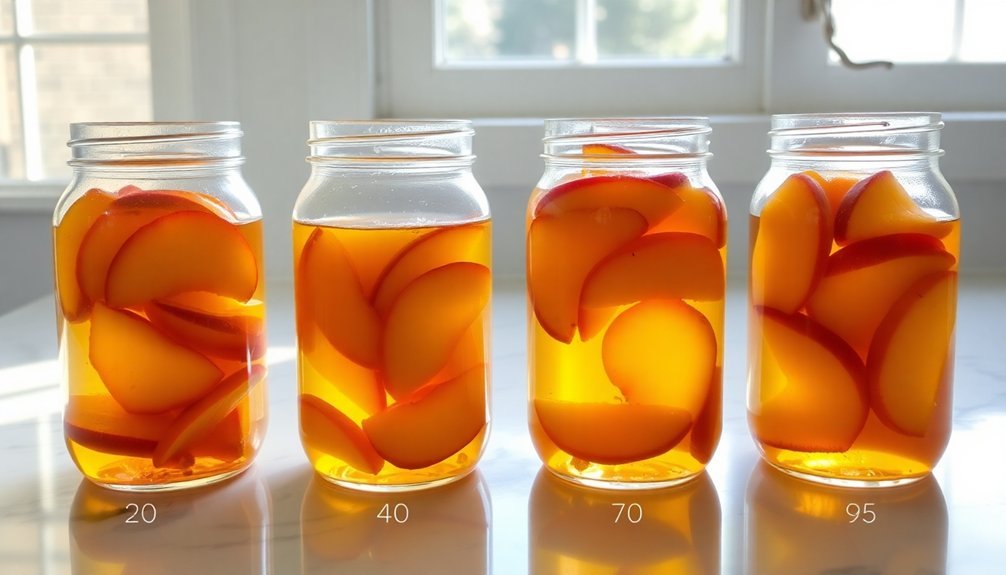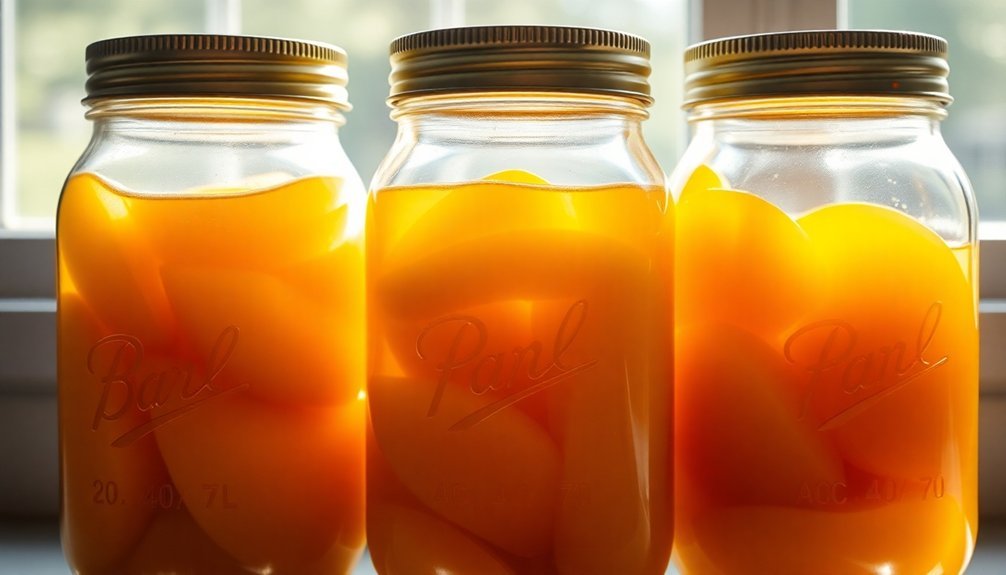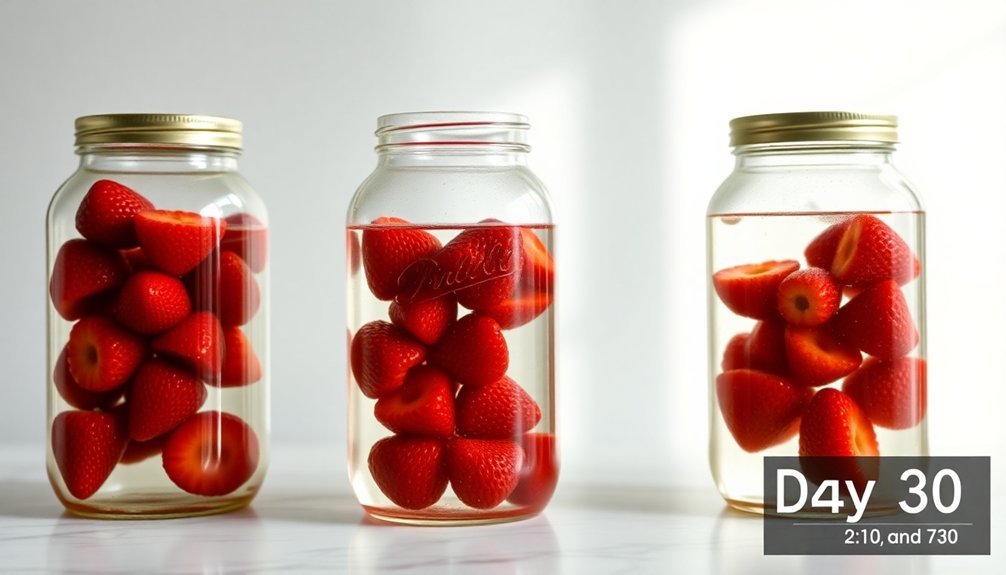A 70% alcohol concentration will keep your food fresh the longest, offering peak preservation power while maintaining proper tissue hydration. You'll find this concentration works best because it effectively kills microorganisms while preventing mold growth – something lower percentages can't match. While wine at 14% can preserve foods for years, it's not as effective as higher concentrations. For best results, you'll want to maintain an acidic environment (pH 3.0-4.0) and guarantee complete food submersion in your alcohol solution. The science behind these preservation methods reveals fascinating insights into how you can maximize your food's shelf life.
The Science Behind Alcohol Preservation

What makes alcohol especially valuable as a preservative is its impact on your food's sensory qualities.
While it's working to preserve your food, it's also maintaining flavor profiles and improving certain characteristics.
You'll notice it helps maintain firmness in produce and can even enhance flavor development through the production of volatile compounds like esters. The use of food grade ethanol ensures these preservation benefits are achieved safely for human consumption.
This dual action of preservation and quality enhancement makes alcohol a powerful tool in food preservation.
Optimal Alcohol Percentages
When you're looking for reliable long-term storage solutions, alcohol concentrations of 70% provide the most effective balance for preserving both food and tissue specimens.
You'll find that alcohol percentages below 40% aren't strong enough to prevent microbial growth, while concentrations above 70% can damage specimens through excessive dehydration. Research shows that ethanol's antimicrobial activity peaks between 60-70%.
For ideal preservative strength, you should rank alcohol solutions from most to least effective: 70% for specimen preservation, 40% for microbial control, and lower percentages offering minimal protection against spoilage.
Long-Term Storage Solutions
The ideal alcohol concentration for long-term food storage sits at 70%, striking a perfect balance between preservation and food integrity. At this level, you'll achieve peak microbial inhibition while maintaining proper tissue hydration in your stored foods. The alcohol effectively disrupts cell membranes of harmful microorganisms while preventing excessive drying of the preserved items. During the preservation process, continued stirring promotes evaporation, which may require monitoring and adjustment of alcohol levels.
When you're setting up long-term storage, you'll need to take into account several key factors. Keep your storage containers tightly sealed to prevent alcohol evaporation, which could compromise the preservative effect. You'll find that food-grade ethanol works best, particularly when you're preserving bakery products or fruits against fungal activity.
For maximum effectiveness, you'll want to maintain consistent storage conditions. If you're using active packaging with ethanol emitters, they'll continuously release small amounts of ethanol into the storage environment, providing ongoing protection.
Remember that while higher concentrations above 40% will prevent microbial growth, sticking to 70% gives you the most reliable results for extended storage periods. This concentration guarantees your stored foods remain protected through protein coagulation and fermentation inhibition, while maintaining their structural integrity.
Preservative Strength Rankings
Understanding alcohol's preservative strength requires a clear ranking system, starting with concentrations as low as 5% and reaching up to 70%. You'll find that different concentrations serve distinct preservation purposes, with higher levels generally providing better protection against spoilage.
| Alcohol % | Preservation Effect |
|---|---|
| 5-11% | Limited protection, reversible antimicrobial effects |
| 18-21% | Ideal for liquid food stability, effective against C. botulinum |
| 40-70% | Maximum preservation, suitable for specimen storage |
For food preservation, you'll want to focus on the sweet spot between 18% and 21%, which provides reliable microbial growth inhibition while maintaining food quality. Wine at 14% can keep for years due to its combination with other preservatives, but it's not as effective as higher concentrations. If you're preserving fruits, you'll need at least 30% alcohol content, typically achieved with spirits like brandy. For laboratory specimens and maximum preservation power, 70% concentration delivers the most reliable results by dehydrating and denaturing proteins while maintaining proper tissue hydration. Remember that complete submersion is essential when preserving items in alcohol to guarantee uniform protection.
Common Food Preservation Applications

Food preservation through alcohol content employs four primary mechanisms: cell wall disruption, protein coagulation, microbial growth inhibition, and cellular process interference. When you're preserving food with alcohol, you'll find these mechanisms work together to create an inhospitable environment for spoilage organisms.
You'll see alcohol preservation most commonly in bakery products, where ethanol emitters in packaging can extend shelf life by several weeks. In breads, the natural fermentation process already produces small amounts of alcohol, but additional ethanol helps prevent mold growth and staling.
When you're preserving fruits, you can submerge them in spirits to protect against fungal activity. This method works particularly well with fruits like Greengage plums in brandy, especially when stored at low temperatures. The combination of alcohol and sugar creates an effective preservation environment.
You'll also find ethanol preservation in everyday products like vanilla extract, vinegars, and some soft drinks. These items use alcohol as both a preservative and a carrier for flavoring compounds.
In active packaging systems, controlled ethanol release helps maintain freshness across various food categories, working synergistically with other preservatives like acids and sulphites.
Safety Considerations
When working with ethanol for food preservation, safety must be your top priority. You'll need to store ethanol in well-ventilated areas away from heat sources and direct sunlight. Always use containers made of compatible materials like HDPE or stainless steel, and guarantee they're properly sealed and labeled.
| Safety Aspect | Requirement | Why It Matters |
|---|---|---|
| Ventilation | Well-ventilated space | Prevents vapor accumulation |
| Temperature | Cool, dry area | Reduces pressure buildup |
| Container | HDPE/stainless steel | Prevents contamination |
| Security | Limited access | Minimizes accidents |
| Protection | PPE and spill kits | Guarantees quick response |
You must maintain ethanol concentrations between 18-21% for effective microbial control, particularly against C. botulinum. Keep in mind that lower concentrations (6-11%) only temporarily inhibit microorganisms. Always follow local regulations regarding flammable liquid storage and maintain accurate documentation of your storage practices. You'll need readily available Material Safety Data Sheets (MSDS) and proper training for all personnel handling ethanol. Remember to implement a secondary containment system to catch potential spills and conduct regular inspections of your storage containers for any signs of damage or corrosion.
Storage Methods and Techniques

Proper storage methods play a vital role in successful alcohol-based food preservation. You'll need to store your alcohol-preserved foods in a dark cupboard to protect them from light exposure, which can compromise the preservation process.
After the initial preservation period, moving your items to the refrigerator will help extend their shelf life, as lower temperatures enhance alcohol's preservative effects.
Your choice of container matters greatly. Always use clean glass jars to prevent contamination, and make sure you're completely submerging the food in alcohol.
During the first few weeks, you'll want to gently shake the container every couple of days to maintain even distribution of the alcohol and sugar mixture.
- Imagine opening your perfectly preserved fruits months later, still bursting with flavor and freshness
- Picture the satisfaction of creating your own preserved delicacies that last longer than store-bought alternatives
- Think about the peace of mind knowing your preserved foods are protected by proper storage techniques
Remember to maintain consistent storage conditions and avoid temperature fluctuations.
If you're using additional ingredients like sugar or vinegar, they'll need to be properly distributed throughout the mixture for best preservation results.
Long Term Preservation Benefits
Building on these storage practices, understanding alcohol's long-term preservation benefits reveals why it's such a powerful preservative. At concentrations around 14%, alcohol effectively acts as a toxic agent against microorganisms, preventing bacterial growth that would otherwise spoil your food.
When combined with other preservatives like sulfur, you'll get even stronger preservation effects.
You'll find that alcohol's preservation power is enhanced by acidic environments, typically with pH levels between 3.0 and 4.0. This combination creates multiple hurdles that pathogens can't overcome. Most harmful microorganisms simply can't survive in these conditions, and even those that initially make it through the acidic environment die off within hours or days at room temperature.
For long-term storage, you'll need higher alcohol concentrations – around 70% – to maintain specimen preservation and prevent mold growth.
However, for products like wine, the natural combination of alcohol, acidity, and polyphenols creates an environment that keeps unopened bottles safe and fresh for at least a year.
Once you've opened the bottle, though, these preservative effects diminish considerably, lasting less than a week before quality deteriorates.
Frequently Asked Questions
Can Homemade Alcohol Solutions Be Used Effectively for Food Preservation?
You can use homemade alcohol solutions for preservation, but you'll need to guarantee they're at least 35-40% alcohol content for best results. It's safer to use commercial spirits for reliable preservation.
How Does Temperature Affect Alcohol's Preservation Capabilities in Food Storage?
You'll notice temperature considerably impacts alcohol's preservative power. When it's too warm, you'll lose preservation effectiveness, while stable, cool temperatures help maintain alcohol's ability to inhibit microbial growth in stored foods.
Which Alcoholic Beverages Work Best for Marinating and Preserving Meat?
You'll get the best results using red wine in marinades after cooking off the alcohol. Spirits and white wine work too, but avoid raw alcohol directly on meat as it can affect texture and flavor absorption.
Does Mixing Different Types of Alcohol Improve Preservation Effectiveness?
You won't gain better preservation by just mixing alcohols. Instead, focus on using spirits with higher alcohol content or wine, which offers natural preservatives and acids that work together for ideal preservation effectiveness.
Can Preserved Foods in Alcohol Be Safely Consumed by Recovering Alcoholics?
You shouldn't consume alcohol-preserved foods if you're in recovery. Even after cooking, these foods retain significant alcohol content and can trigger relapse. It's safer to choose alternative preservation methods or alcohol-free options.
In Summary
You'll find that 40-70% alcohol content works best for food preservation, striking the ideal balance between antimicrobial action and preventing moisture loss. For fruits, aim closer to 40%, while herbs and spices can handle up to 70%. Remember to properly seal your containers and store them in a cool, dark place. Always follow safety guidelines and check preservation progress regularly to guarantee your food stays fresh.





Leave a Reply